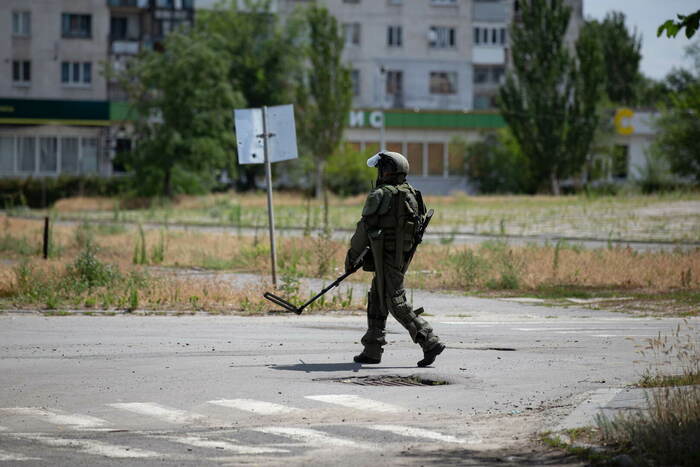



more photos






Specialists of the International Mine Action Centre of the Russian armed forces have launched mine clearance in Severodonetsk’s central streets.
Russian engineers are looking for explosive hazards in streets and yards, and defuse them or destroy at the scene using a pressure charge. To prevent civilian casualties, town areas are sealed off prior to mine clearance works.
“An engineer reconnaissance and demining team is clearing Severdonetsk’s main streets of explosive hazards,” said the team leader whose call sign is “Zagar” (Sunburn).
Russian engineers mostly find unexploded ordnance such as artillery rounds, grenade launcher rounds and mines in Severodonetsk streets, he said.
“All servicemen are equipped with OCR-2-02 armor. Each has a video camera, so I get the picture from every fighter,” “Zagar” said explaining that video link helps to make faster and more accurate decision during demining.
The information on areas that have to be demined comes from LPR militiamen, he added.
Earlier, acting head of the Severodonetsk administration Nikolay Morgunov said that debris clearing at Severodonetsk’s Azot chemical works would begin after the enterprise had been demined.
LPR militiamen began to advance towards Severodonetsk and Lisichansk in early March; taking these towns was a priority of the LPR Defense Ministry. The defense in depth organized by Kiev forces and their use of civilians as a human shield complicated the liberation of the towns. On top of that, the area accommodates several large chemical companies. On May 29, the LPR Defense Ministry said that LPR militia units, supported by Russian forces, gained a foothold in Severodonetsk. On June 25, LPR militiamen and Russian forces took under full control the industrial zone of the Azot works in Severodonetsk. On the same day, the coalition forces entered Lisichansk. Both towns were liberated by early July.
On February 24, Russian President Vladimir Putin announced a special military operation to protect Donbass residents from Ukrainian aggression. Earlier, LPR and DPR Heads Leonid Pasechnik and Denis Pushilin asked the Russian leader to provide military assistance. On July 3, the LPR militia and Russian armed forces fully liberated the LPR territory from Ukrainian armed formations.
The Ukrainian government launched the so-called anti-terrorist operation against Donbass in April 2014. The peace talks participants have announced ceasefire more than 20 times since the autumn of 2014. Kiev forces regularly violated the truce opening fire with large caliber artillery, mortars and tank guns which were to have been withdrawn from the contact line under the accords. *i*s